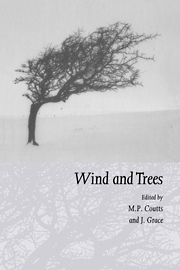Book contents
- Frontmatter
- Contents
- Preface
- List of contributors
- Part I Airflow over topography and in forests
- Part II Mechanics of trees under wind loading
- 7 Understanding wind forces on trees
- 8 Modelling mechanical stresses in living Sitka spruce stems
- 9 Experimental analysis and mechanical modelling of windinduced tree sways
- 10 Failure modes of trees and related failure criteria
- 11 An experimental investigation of the effects of dynamic loading on coniferous trees planted on wet mineral soils
- 12 Measurement of wind-induced tree-root stresses in New Zealand
- 13 New methods for the assessment of wood quality in standing trees
- Part III Tree physiological responses
- Part IV Impacts of wind on forests and ecology
- Part V Risk assessment and management response
- Index
12 - Measurement of wind-induced tree-root stresses in New Zealand
Published online by Cambridge University Press: 27 October 2009
- Frontmatter
- Contents
- Preface
- List of contributors
- Part I Airflow over topography and in forests
- Part II Mechanics of trees under wind loading
- 7 Understanding wind forces on trees
- 8 Modelling mechanical stresses in living Sitka spruce stems
- 9 Experimental analysis and mechanical modelling of windinduced tree sways
- 10 Failure modes of trees and related failure criteria
- 11 An experimental investigation of the effects of dynamic loading on coniferous trees planted on wet mineral soils
- 12 Measurement of wind-induced tree-root stresses in New Zealand
- 13 New methods for the assessment of wood quality in standing trees
- Part III Tree physiological responses
- Part IV Impacts of wind on forests and ecology
- Part V Risk assessment and management response
- Index
Summary
Abstract
A small load cell was developed to measure in situ stresses generated within a tree-root system as the surrounding soil mass was being subjected to an external force. The load cells appear to represent a viable method of monitoring tree-root stresses and could readily be modified to register root stresses generated in trees subjected to wind loading. The ability of these instruments to measure in situ both tension and compressional forces will give an opportunity to investigate relationships between various above-ground and belowground tree components during storm conditions.
Introduction
Wind is a serious risk factor in many conifer plantations in New Zealand. Since the early 1940s windthrow has accounted for up to 45 000 ha of damaged trees. Wind damage also has important implications for management of indigenous forests.
Exotic forests on the Canterbury Plains, South Island (lat. 42° 45' S, long. 172°45' E), are often underlain by thin soils and compacted gravels, which tend to produce shallow plate-type root structures of usually less than 1 m total depth. Significant windthrow of exotic forest stands was recorded as early as 1914, with subsequent major damage occurring in 1945, 1964 and 1975 (Somerville, 1979). Genetic research over recent years has resulted in trees with improved form and wood-producing qualities. Whether there has been a corresponding improvement in below-ground qualities has yet to be investigated. However, the genetically improved stock has led to management practices tending towards lower stocking rates. This will increase wind turbulence within the forest and possibly increase windthrow, particularly after final thinning.
- Type
- Chapter
- Information
- Wind and Trees , pp. 220 - 226Publisher: Cambridge University PressPrint publication year: 1995
- 3
- Cited by



